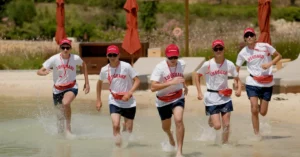Weather plays a pivotal role in the life of a lifeguard. The conditions that a lifeguard faces can vary greatly with the changing weather. From blazing sunshine to torrential rain, lifeguards must adapt to ensure the safety of beach and pool-goers.
In this article, we will explore the changes that a lifeguard goes through with the shift in weather conditions.
Sunny Skies: A Lifeguard’s Best Friend
When the sun shines brightly in the sky, it’s a lifeguard’s dream. The clear skies and warm weather bring out crowds of swimmers and sunbathers. Lifeguards can relax, knowing that visibility is optimal, and water conditions are usually calm. Sunscreen is their best friend during these days, protecting them from harmful UV rays.
Heat and Hydration: The Challenges
But even under the sunny skies, there are challenges. The scorching heat can be brutal. Lifeguards must remain vigilant, keeping an eye out for signs of heatstroke in beachgoers and themselves. Dehydration is a real concern, and lifeguards must drink water regularly to stay hydrated.
Crowds and the Chaos of Summer
The summer season often brings larger crowds, especially at beach destinations. As a lifeguard, managing crowds can become a daunting task. Ensuring everyone’s safety becomes even more critical. Lifeguard training prepares them for this, teaching them crowd control techniques and communication skills to maintain order.
Rainy Days: A Lifeguard’s Dilemma
On the flip side, when the weather turns gloomy and rain starts pouring, the lifeguard’s role undergoes a significant change. The beach or pool may become deserted, but lifeguards must remain on duty. The threat of sudden weather changes and lightning necessitates their presence.
The Lightning Hazard
When thunder roars, lifeguards must be proactive in clearing the water. Lightning poses a severe threat, and lifeguards are trained to follow strict safety protocols. They must ensure that no one remains in the water during a storm, even if the rain seems to have passed. Lifeguard classes near me emphasize these safety procedures for handling lightning.
Swift Water and Rip Currents
Rain can also lead to an increase in water levels, creating swift currents in rivers and streams. Lifeguards trained in swiftwater rescue techniques play a crucial role during these conditions. They must be equipped to handle these challenging water environments, ensuring that no one gets swept away by the strong currents.
Fog and Reduced Visibility
Foggy weather can be a lifeguard’s worst nightmare. Reduced visibility makes it challenging to spot swimmers in distress. Lifeguards on duty during foggy days need to rely on their training to scan the water for any signs of trouble. It’s a test of their observation skills and quick reaction time.
Winter Chill: A Different Lifeguarding Experience
As the seasons change and winter sets in, the role of a lifeguard takes on a different character. Lifeguarding at indoor pools becomes more common, with outdoor venues closing due to the cold. Lifeguards may also have to deal with icy conditions around pool decks, making safety a top priority.
Ice and Snow: Hazards Around the Pool
When snow and ice accumulate, lifeguards must ensure that the pool area is safe for use. Slippery surfaces can lead to accidents, so they must be diligent in clearing these hazards. It’s a different kind of vigilance, as the focus shifts from water-related dangers to those associated with winter conditions.
Training for Cold Water Rescues
Winter weather also brings cold water swimming and the need for cold water rescue training. Lifeguard training equips individuals with the knowledge and skills needed to save lives in freezing water conditions. Specialized gear and techniques become essential, and lifeguards must be prepared to respond to hypothermia cases.
Off-Season Preparation
During the off-season, lifeguards often take part in refresher courses and training to maintain their certification. Lifeguard classes near me provide opportunities for lifeguards to practice their skills and stay updated on the latest techniques and safety protocols.
Year-Round Commitment
It’s crucial to understand that lifeguarding is a year-round commitment. While the specifics of the job may change with the weather, the underlying responsibility remains the same: to ensure the safety of those in and around the water. This commitment to safety and rescue is what defines a lifeguard.
American Lifeguard Association: Setting Standards
The role of a lifeguard is greatly influenced by weather changes. From sunny summer days to rainy storms, lifeguards must adapt to ensure the safety of all water enthusiasts. Regardless of the weather, lifeguard training and certification play a vital role in preparing lifeguards for the diverse challenges they may face.
So, if you’re interested in becoming a lifeguard or seeking lifeguard classes near me, remember the importance of this year-round commitment. It’s a noble and critical profession that saves lives, regardless of the weather conditions.
The American Lifeguard Association sets the standards for lifeguarding excellence, ensuring that lifeguards are well-prepared for whatever Mother Nature throws their way.
